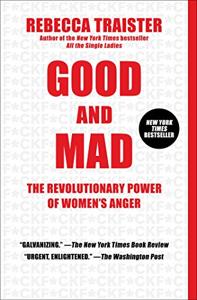
Want to learn the ideas in Good and Mad better than ever? Read the world’s #1 book summary of Good and Mad by Rebecca Traister here.
Read a brief 1-Page Summary or watch video summaries curated by our expert team. Note: this book guide is not affiliated with or endorsed by the publisher or author, and we always encourage you to purchase and read the full book.
Video Summaries of Good and Mad
We’ve scoured the Internet for the very best videos on Good and Mad, from high-quality videos summaries to interviews or commentary by Rebecca Traister.
1-Page Summary of Good and Mad
Overview
Since the beginning of 2017, women have been more politically active and vocal than ever before. This is a result of an anger that has been brewing for decades. More and more women are speaking out about their frustrations with current events.
People may have wondered why the anger from the 1970s was so prominent. What happened to it? Why did it go away? This essay tries to answer those questions by looking at how and why the anger disappeared, what brought it back, and its significance in today’s society.
To answer these questions, we’ll look at some facts and insights into this issue.
In this piece, you’ll learn how male politicians can get away with expressing anger in a way that women cannot. You’ll also learn about the differences between white and black feminism, as well as what Beyoncé’s music says about the modern day feminist movement.
Big Idea #1: After erupting in the 1960s and 1970s, feminist political anger subsided in the 1980s.
Before we look at the reasons for feminist anger, let’s take a brief look at how and why this emotion has appeared in modern times.
Our story begins in the 1960s and 1970s. These were tough times, with racial injustice, gender inequality and war.
Feminists have been fighting for equality. They were criticized by people who thought they were being too extreme, so the feminists embraced their critics’ words and became more extreme in their actions. At one point, some of them wore costumes to express themselves while protesting.
They also took their activism to increasingly radical measures. For example, when abortion was illegal in the United States, feminists set up an underground network called the Jane Collective that enabled over 11,000 women to obtain safe abortions between 1969 and 1973.
Feminists gained many legal advances in the 20th century. These included making birth control and abortion legal, as well as laws that made it easier for women to divorce. They also won a court decision defining sexual harassment as a form of discrimination against women.
Then, the Reagan Revolution happened. With the ascendancy of Ronald Reagan and his fellow right-wing Republicans, many social programs and abortion access were restricted. Many poor women had no support left.
Meanwhile, career-oriented women were portrayed as overly sexual she-devils or cold-hearted shrews in popular culture. In films like Fatal Attraction and Working Girl, they were shown to be in need of a man to marry them.
In the context of this time period, feminist political anger was dormant. It occasionally reappeared in the 1990s but mostly stayed quiet until 2017 when it came back to life.
Big Idea #2: Feminist political anger flared up in the 1990s, but it was a short-lived flame.
From the 1980s to 2017, feminist political anger was mostly on the back burner. However, there were a few occasions when this anger was roused. One of these times occurred in 1991 with Anita Hill’s allegations against Clarence Thomas during his Supreme Court nomination hearings.
Many women were outraged by the way Anita Hill was treated during her testimony, and they felt that Clarence Thomas got away with sexually harassing her. As a result, many women ran for office in 1992 because of their anger over what happened to Hill and how she was treated. They won 24 seats in the House of Representatives and 4 seats in the Senate.
In the 1980s and early 1990s, women started to get more involved in politics. However, it wasn’t until 1992 that their numbers began to rise again.
Feminism is still around, but it’s changed. It was once very angry and active, but now it’s less so. Many feminists have moved away from anger to make feminism more appealing to the mainstream. They’ve done this by embracing a form of humor that appeals to both men and women while reassuring them about their own beliefs.





